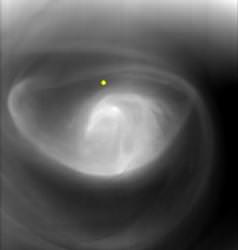ESA’s Venus Express has been constantly watching the huge swirling vortex of clouds around Venus’ southern pole. It’s a strange weather feature, morphing and changing shape within just a few days. And scientists, as you can probably imagine, are puzzled about what’s going on.
Venus’ south pole vortex is similar to a hurricane here on Earth. It measures 2,000 km (1,240 miles) across, and was discovered by the Mariner 10 flyby in 1974. A second, similar vortex was found at the planet’s north pole by the Pioneer Venus mission in 1979.
“Simply put, the enormous vortex is similar to what you might see in your bathtub once you have pulled out the plug” says Giuseppe Piccioni, co-Principal Investigator for the Visible and Infrared Thermal Imaging Spectrometer (VIRTIS) on Venus Express, at IASF-INAF, Rome, Italy.
When Venus express observed the vortex in June 2006, it had a roughly hourglass-shape, similar to what Pioneer Venus saw in the north polar region. But with continued observations from Venus Express, scientists are seeing that the storm is much more fickle than they previously thought.
Over the course of just a single day, scientists watched the shape of the storm’s vortex change from a circle to a oval. It’s believed that atmospheric gases are flowing into the region from different directions at different altitudes. The shape of the vortex is a result of changes in temperature across different parts of the planet.
The actual vortex is created because atmospheric gases are heated by the Sun at the equator. They cool near the polar regions and sink down. The rotation of Venus deflects them sideways so they swirl together, like water going down the drain of a bathtub.
Original Source: ESA News Release


Question: What would happen to Venus’ atmosphere if sunlight could be cut down or blocked completely from it?
Marcellus,
Venus has no internal heat source like gas giants. The atmosphere would cool, lowering its energetic state and therefore its speed. The greenhouse effect that keeps the surface and inner atmosphere hot would simply have no external input. The atmosphere would freeze and be deposited on the surface as frost. If you cut off only a portion of the sun’s energy, then the atmosphere would cool, the excess heat at the surface would dissipate, the polar vortices would wane and the planetary atmospheric circulation would complexitize like here on earth. However, less so because of the lack of oceans. There is no water in the atmosphere there so you wouldn’t see rain but other effects would take place and we’d seriously start looking at Venus as a potential sister planet to our own in its potential habitability.
Except that the atmosphere would still be poisonous.
Minor consideration.
Marcellus : That basically describes the situation that already exists. The planet is covered completely in thick clouds.
The result is a greenhouse effect – warming gases are unable to escape.
What would really be interesting is if there was a storm that vented a large portion of Venus’ clouds into space. Then the planet might begin to cool and some day actually be inhabitable.
Wait a second. They’re saying that the planet’s rotation deflects the air masses sideways. But Venus has virtually no real rotation. Gives one pause for thought….
Tyler Durden, you should pay attention when you read something. I said what would happen to Venus’ ATMOSPHERE not Venus’ surface.
Peter K’s answer is what I was looking for, (thank you, Peter) a consise intelligent reply. Yours certainly is not.
Sub: DMVT OROCESS
Vortex Tube process from Venus – observarion- confirms my approach.
Double Magnetic Vortex Tube process – outlined in my books- holds the key for life on Earth Planet.
Search beyond 100 AU for solutions on the Earth pLanet. For details one contact me or see projections in my books
http://cosmologyvedas.blogspot.com/
Vidyardhi Nanduri
Hyperdimensional physics anyone?